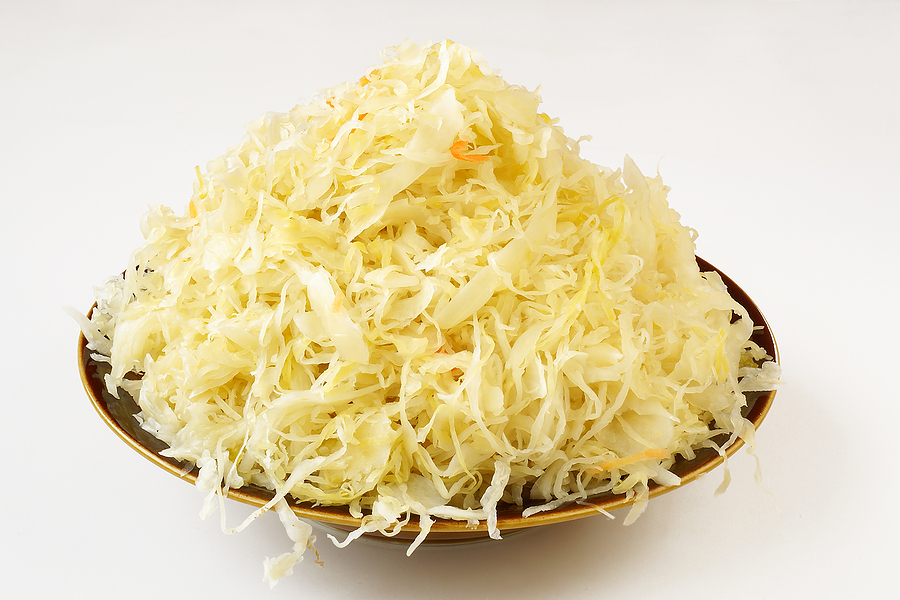Daily Healthy Options: #4 Eat More Sauerkraut!

The benefits of fermented foods are tremendous. With its extraordinarily high Vitamin C content to regulating good cut bacteria, fermented foods are a dying breed.
Non-fermented cabbage already contains moderate amounts of vitamin C about 30 mg per cup.
When cabbage is fermented into sauerkraut, antioxidants and its vitamin C levels skyrocket.
"According to research at Cornell University, levels of antioxidants and vitamin C in sauerkraut range from 57 to 695 mg—with raw, fermented red cabbage having the highest levels of vitamin C, hitting almost 700 mg per cup."
Sauerkraut also contains other antioxidants that protect against stress and fight disease. The beneficial probiotics in sauerkraut inoculate the gut and further fortify the immune system. Sauerkraut and other raw, fermented foods made with cabbage, like Kimchi, are true superfoods that have a long history of protecting the body when resources were scarce.
Easy Sauerkraut recipe
Homemade Sauerkraut Recipe
prep 30 minsinactive 336 hourstotal 336 hours, 30 mins
author wellness mama
yield 2 quarts
Enjoy delicious, crisp, perfectly salty kraut for months! Only takes 30 minutes of hands-on prep. This traditionally made sauerkraut is brimming with healthy probiotics.
Ingredients
2 heads of cabbage (about five pounds)
1/4 cup of salt (*see note below)
1-2 TBSP caraway seeds (optional)
fermentation crock with weight OR 2 quart-size or one half-gallon size mason jars with fermentation weights and
airtight lid
Instructions:
Get things clean - Wash all equipment, work surfaces, and your hands in warm soapy water.
Slice the cabbage - Remove the outer leaves and cores from cabbage. (Compost them if you can!) Slice the cabbage into quarters for easier slicing. Then, thinly slice cabbage into very thin ribbons. If you have one, a food processor speeds up this process.
Add the salt - Place the thinly sliced cabbage in a large bowl (make sure it is clean too!). Sprinkle the salt over it. Knead and squish the cabbage/salt with your hands for about ten minutes. At first, it won't seem like it is doing anything at all, but be patient. After a few minutes, the cabbage will start releasing liquid and by the end, there should be enough liquid brine to cover the cabbage in the crock or jar. Add the caraway seeds at this point if you are using them.
Move it to the fermentation vessel - Stuff the cabbage very tightly into the jars or fermentation crock. Pour any liquid from the bowl into the jar. If needed, add just enough water to make sure the water/brine covers the cabbage entirely. If the cabbage is fresh, no liquid may be needed, but don't worry if you have to add a little water.
Weigh and cover - Add the fermentation weights and fermentation seal (or use the fermentation crock as directed). If you are just using a basic mason jar, you can also do this by adding a smaller jar that just fits inside the lid of the mason jar and covering both jars with a cloth and a rubber band.
Let it ferment - Now you get to practice patience! Fermentation will begin within a day and take 2-5 weeks depending on temperature and desired tartness. After 2 weeks, check for desired tartness. The sauerkraut is technically slightly fermented after only a few days, but the best flavor seems to be at the 2-3 week mark. Taste is the best measure here, so check it often and stop the ferment when you get the desired taste. Note: It is normal to see bubbles, white scum, or foam on top during the fermentation. You shouldn't see any actual mold, though. If you do, scrape it off the top, and make sure all the rest of the cabbage is fully submerged. All cabbage below the brine level should still be fine.
ool it down - Once fermented, it can be eaten right away, or it will store in the refrigerator for up to six months.
Enjoy! Sauerkraut is delicious on its own or added to salads, soups, or on top of meats.
Notes
*The salt should be at a ratio of about 2% by weight. If you have a digital scale, it is worth weighing the cabbage and the salt if you want to get the perfect ratio for the brine. I find it easiest to weigh the cabbage (in grams) and then I calculate 2% of the weight of the cabbage to use in salt. Any high-quality salt will work but I find the best results when I use this one.
**Nutrition data may vary based on fermentation time. Longer ferments will break down more of the naturally occurring carbohydrates in cabbage. Also, a ½ cup serving size can vary greatly based on how it is measured (scooped vs. packed down).